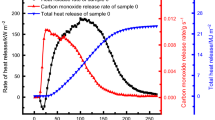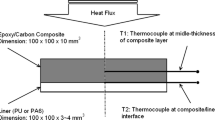Abstract
A comparative analysis of the properties of two samples of hybrid polyurethane–inorganic thermal insulation is presented. The indicators of their fire danger are determined by standard methods. Both samples are moderately combustible materials of group G2 according to GOST (State Standard) 30244–94 belong to the group of inflammable materials B3 according to GOST (State Standard) 30402–96 and exhibit moderate smoke generation ability in smoldering mode (group D2) according to GOST (State Standard) 12.1.044–89. It has been established that thermal-insulation samples retain their shape when heated under dynamic conditions in air up to 850°C. Shrinkage was up to 25–29% in different temperature ranges due to decomposition of the organic component. Thermal-oxidative decomposition of the investigated samples of hybrid thermal insulation is a multi-stage process. Based on the results of thermal analysis (TG, DTG, DSC) carried out in air at heating rates of 5, 10, 20, and 100°C/min, the mechanism and macrokinetic parameters of decomposition at each stage were determined. The obtained parameters are used to determine the regime that controls the process of gasification and shrinkage of samples of hybrid thermal insulation.




Similar content being viewed by others
REFERENCES
S. Papra, “The future of high-performance polymer foams to 2021,” https://www.smithers.com.
“Polyurethane foam market by type (rigid foam, flexible foam, spray foam), end-use industry (building & construction, bedding & furniture, automotive, electronics, footwear, packaging, others), and region—global forecast to 2025 // markets and markets,” https://www.marketsandmarkets.com.
S. V. Levchik and E. D. Weil, “Thermal decomposition, combustion and fire-retardancy of polyurethanes. A review of the recent literature,” Polymer. Intern. 53, 1585—1610 (2004). https://doi.org/10.1002/pi.1314
Q. Zhao, C. Chen, et al., “Halogen-free flame-retardant rigid polyurethane foam with a nitrogen- phosphorus flame retardant,” J. Fire Sci. 35, 99—117 (2017). https://doi.org/10.1177/0734904116684363
L. Liu, Z. Wang, and X. Xu, “Melamine amino trimethylene phosphate as a novel flame retardant for rigid polyurethane foams with improved flame retardant, mechanical and thermal properties,” J. Appl. Polym. Sci. 52, 4700—4712 (2017). https://doi.org/10.1002/app.45234
M. Modesti et al., “Synergism between flame retardant and modified layered silicate on thermal stability and fire behavior of polyurethane nanocomposite foams,” Polym. Degrad. Stab. 93, 2166—2171 (2008). https://doi.org/10.1016/j.polymdegradstab.2008.08.005
G. Lorusso, F. Conciauro, et al., “Thermal and mechanical performance of rigid polyurethane foams added with commercial nanoparticles,” Nanomaterials and Nanotechnology 7, 1–9 (2017). https://doi.org/10.1177/1847980416684117
H. Yang et al., “Aluminum hypophosphite in combination with expandable graphite as a novel flame-retardant system for rigid polyurethane foams,” Polym. Adv. Techn. 25, 1034—1043 (2014). https://doi.org/10.1002/pat.3348
A. L. Pomogailo, “Hybrid polymer-inorganic nanocomposites,” Uspekhi Khimii, 69, 69–89 (2000).
M. V. Pigaleva, I. V. Elmanovich, M. N. Temnikov, et al., “Organosilicon compounds in supercritical carbon dioxide: Synthesis, polymerization, modification, and production of new materials,” Polym. Sci., Ser. B 58, 235–270 (2016).
L. Verdolotti, M. Lavorgna, et al., “Polyurethane-silica hybrid foam by sol–gel approach: chemical and functional properties,” Polymer 56, 20–28 (2015). https://doi.org/10.1016/j.polymer.2014.10.017
E. H. Song, S. H. Jeong, et al., “Polyurethane–silica hybrid foams from one-step foaming reaction coupled with a sol-gel process for enhanced wound healing,” Mater. Sci. Eng. Mater. Biol. Appl. 79, 886–874 (2017).
S. Chatterjee, K. Shanmugamathan, and G. Kumaraswany, “Fire retardant, self-extinguishing inorganic/polymer composite memory foams,” ACS Appl. Mater. and Interface 9, 44864–44872 (2017).
Ch. Mandal et al., “Transparent, mechanically strong, thermally insulating cross-linked silica aerogels for energy efficient windows,” J. Sol-Gel Sci. Techn. 92, 84—100 (2019).
A. A. Kobelev, E. Yu. Kruglov, Yu. K. Naganovskii, R. M. Aseeva, and B. B. Serko, “Thermal-oxidative destruction of polyisocyanurate foam insulation,” Vse Materialy. Entsiklopedicheskii Spravochnik, No. 11, 31—40 (2018). https://doi.org/10.31044/1994-6260-2018-0-12-31-39
A. Calgano, C. Di Blasi, et al., “Numerical simulation of the glowing combustion of moist wood by means of a front-based model,” Fire and Materials 38, 639—658 (2014).
B. Peters, A. Dringys, and R. Navakas, “A shrinking model for combustion/gasification of char based on transport and reaction scales,” Mechanica 18, 177—185 (2012).
W. Huo, Z. Zhou, F. Wang, and G. Yu, “Mechanism analysis and experimental verification of pore diffusion on coke and coal char gasification with carbon dioxide,” Chem. Eng. J., No. 244, 227—233 (2014).
S. V. Nesterov, I. N. Bakirova, and Ya. D. Samuilov, “Thermal and thermal-oxidative degradation of polyurethanes: mechanisms of percolation, factors of influence and main methods for improving thermal stability. Review based on materials of domestic and foreign publications,” Vest. Kazan Tekhnol. Univ. Khimiya, No. 14, 10–23 (2011).
C. Y. H.Chao and J. H. Wang, “Comparison of the thermal decomposition behavior of a non-fire retarded and a fire retarded flexible polyurethane foam with phosphorus and brominated additives,” J. Fire Sci. 19, 137—135 (2001). https://doi.org/10.1106/Q56W-KUDB-0VRT-6HLF
Author information
Authors and Affiliations
Corresponding author
Additional information
Translated by M. Drozdova
Rights and permissions
About this article
Cite this article
Kobelev, A.A., Kruglov, E.Y., Aseeva, R.M. et al. Hybrid Polyurethane–Inorganic Thermal Insulation: Fire Hazard and Thermo-Oxidative Decomposition. Polym. Sci. Ser. D 15, 715–723 (2022). https://doi.org/10.1134/S1995421222040451
Received:
Revised:
Accepted:
Published:
Issue Date:
DOI: https://doi.org/10.1134/S1995421222040451




